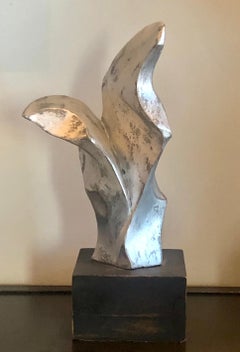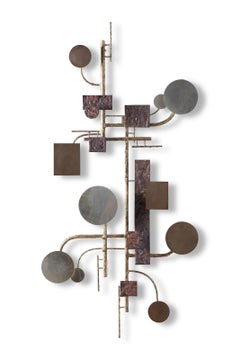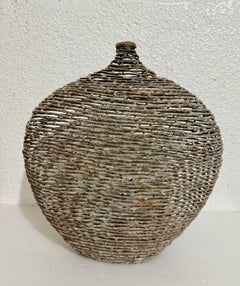George L.K. Morris Sculptures
to
1
Overall Width
to
Overall Height
to
1
1
1
1
4
215
183
166
136
1
Artist: George L.K. Morris
Abstract Sculpture Mid 20th Century Modern Non Objective Biomorphic Plaster WPA
By George L.K. Morris
Located in New York, NY
Modern artist George L.K. Morris created this abstract biomorphic nonobjective plaster sculpture during the WPA era of the 1930s / 40s. Monogrammed.
Though George Lovett Kingsland Morris studied with realist painters John Sloan and Kenneth Hayes Miller at the Art Students League, the influence of their points of view was replaced by that of abstractionists Amedee Ozenfant and Fernand Leger. The paintings of Morris were two-dimensional, hard-edged and brightly colored.
Born in New York City in 1905, Morris became a full-fledged abstractionist and a founder in 1936 of the American Abstract Artists. He edited "The World of Abstract Art, the group's publication, and was their president from 1948-1950.
Morris had graduated from Yale in 1928 and studied at the League until 1930, when he went to Paris to attend the Academie Moderne. A sculptor, writer, art critic and teacher in addition to abstract painter Morris himself later taught at the Art Students League from 1943-1944, as well as St. John's College, Annapolis, Maryland, 1960-1961.
Morris' intrinsic abstract bent was made even clearer by his positive feeling for Hans Arp's sculpture. He and Arp edited the French art magazine, "Plastique." Morris also edited the "Bulletin of the Museum of Modern Art" and "Partisan Review."
He died in 1975 in New York City.
George LK...
Category
1930s American Modern George L.K. Morris Sculptures
Materials
Plaster
Related Items
Mid-Century Modern Brutalist Geometric Wall Sculpture by Stuart Mathews 1970s
Located in Dallas, TX
Mid-Century Modern Brutalist Geometric Wall Sculpture by Stuart Mathews, 1970s
A bold and architectural statement piece, this original 1970s wall sculpture by Texas artist Stuart Mat...
Category
1970s American Modern George L.K. Morris Sculptures
Materials
Metal
$4,400
H 58.75 in W 30 in D 7.25 in
American Craft Studio Handmade Sculpture Welded Bronze Kinetic Vessel Op Art
Located in Surfside, FL
Great studio piece. It does not appear to be signed.
Welded bronze
an openwork vessel or vase
Verdigris patina, might be suitable for outdoors
Dimensions: 18 X 16 X 9 inches
Provena...
Category
20th Century American Modern George L.K. Morris Sculptures
Materials
Bronze
$1,500
H 18 in W 16 in D 9 in
"Untitled" Beverly Pepper, Ultra Marine Blue and Steel Architectural Sculpture
By Beverly Pepper
Located in New York, NY
Beverly Pepper
Untitled
"BP" monogram stamped on the base
Stainless steel and enamel
6 x 6 3/4 x 3 1/8 inches
Born in 1922 in Brooklyn, Pepper trained to as a painter with Fernand ...
Category
1960s American Modern George L.K. Morris Sculptures
Materials
Enamel, Stainless Steel
$7,500
H 6 in W 6.75 in D 3.125 in
Eugene Caples "Bronze Sculpture II" Abstract Bronze Sculpture
By Eugene Caples
Located in Detroit, MI
This small exquisite "Bronze Sculpture II" is in excellent condition and a perfect example of Eugene Caples craftsmanship. This is mainly abstract with some graphic or architectural elements and is so delightful that mythical creatures demand to be considered. It cries out to be touched and held, looked at and caressed. The beautiful patina on the surface gives voice to the many hands that have done these things.
Eugene Caples is a designer and craftsman who worked in Kansas City in the 1960s and later through the early 21st century. He attended the Kansas City Art Institute, earning his Bachelors of Fine Arts in Industrial Design in 1959. In 1963 he was accepted to Cranbrook Academy of Art, Bloomfield Hills, Michigan. The Cranbrook Academy of Art was designed by architect and faculty member, Eliel Saarinen who collaborated with Charles and Ray Eames on chair and furniture design. Numerous creative artists are alumni of Cranbrook and include: Harry Bertoia, Florence Knoll, Jack Lenor Larsen, Donald...
Category
Late 20th Century American Modern George L.K. Morris Sculptures
Materials
Bronze
$1,950
H 4.75 in W 4 in
Large Brutalist Welded Steel Wall Sculpture by Dan Gluck - 1970s
Located in Dallas, TX
A commanding example of Brutalist artistry, this large-scale wall-mounted sculpture by Dan Gluck is composed of intricately welded steel elements arranged in a dynamic abstract compo...
Category
Mid-20th Century American Modern George L.K. Morris Sculptures
Materials
Steel
$4,800
H 39 in W 55 in D 6 in
Mid-Century Metal and Colored Glass Sculpture - Like Stained Glass - Gaudi
Located in Miami, FL
Mid-Century enameled steel, glass sculpture that is visually balanced from 360 degrees. All the positive and negative spaces work in total harmony which is a testament to Samuel Cashwan...
Category
1950s American Modern George L.K. Morris Sculptures
Materials
Steel
Samuel CashwanMid-Century Metal and Colored Glass Sculpture - Like Stained Glass - Gaudi, 1955 circa
$28,000
H 28.5 in W 4.25 in D 4.75 in
Breathtaking John Glick "Scalloped Basket" Glazed Stoneware Reduction Fired
Located in Detroit, MI
"Scalloped Basket" is a stoneware piece with the decorative layer of the rich toned glazes and markings that John was so well-known for. He was, also, known for the undulating lip lines on his exquisite pieces. The basket portion is shaped with gentle curves and a sculptural handle. Each piece that John produced was unique. He was seduced by the effects of the reduction kiln, which decreased the levels of oxygen during firing, inducing the flame to pull oxygen out of the clay and glazes changing the colors of the glazes depending on their iron and copper content. In this way he achieved the rich gradients of ochre and umber and variations in stippling and opacity. This particular "basket" also has the cool blues and grays that contrast with the umber. It is signed and stamped on the bottom.
John was an American Abstract Expressionist ceramicist born in Detroit, MI. Though open to artistic experimentation, Glick was most influenced by the styles and aesthetics of Asian pottery—an inspiration that shows in his use of decorative patterns and glaze choices. He has said that he is attracted to simplicity, as well as complexity: my work continually reflects my re-examination that these two poles can coexist… or not, in a given series. Glick also took influences from master potters of Japan, notably Shoji Hamada and Kanjrio Kawai, blending their gestural embellishments of simple forms with attitudes of Abstract Expressionism. He was particularly drown to the work of Helen Frankenthaler whose soak-stain style resonated with Glick’s multi-layered glaze surfaces, which juxtaposed veils of atmospheric color with gestural marks and pattern. He spent countless hours developing and making his own tools in order to achieve previously unseen results in his work with clay and glaze.
Glick’s “Plum Tree Pottery...
Category
1970s American Modern George L.K. Morris Sculptures
Materials
Stoneware, Glaze
$2,800
H 6 in W 11.38 in D 9 in
Bronze Architectural Model Sculpture Tempio Bretton Architecture Maquette
Located in Surfside, FL
TEMPIO BRETTON: from the catalogue MONUMENTA, 19th International Sculpture Biennale, Antwerp, Belgium.
Tempio Bretton was created in homage to the celebrated English landscapist Capability Brown for the occasion of an exhibition at Bretton Hall in the Yorkshire Sculpture Park , a park in the style of the great master of English garden design. The inclusion in the English garden of a temple ruin, or "eye-catcher," (architectural folly) was used to draw the eye and mind to a focus in time and space, present the beholder with an immediate relationship to an historic past made new within his or her own surroundings, and create a depth of space never before seen in garden design.
I took the idea of the temple ruin eye-catcher and reduced it to a scale at the point where architecture and sculpture merged. Tempio Bretton is not capacious enough to walk into, yet it is considerably larger than a man.
One view of it presents a knot of golden columns clustered together, topped by a dome shape. The only clue from this side to the temple's non-conformity to historic principle is a sharp notch cut into the square base.
Viewed from the opposite side, the cluster of columns capped by an angular top opens up as if to welcome someone in, yet the mysterious core is still impenetrable. These contradictions articulate a confrontation between past and present, and an exciting truth. The past is always at the heart of our constructions in the present.
Walter Dusenbery (born September 21, 1939 in Alameda, California) is an American sculptor. He attended the San Francisco Art Institute, earned an MFA from California College of Arts and Crafts, and then studied in Japan and Italy under Isamu Noguchi. He also held teaching positions at Harvard University and University of California, Berkeley Graduate School of Design. From 1971 to 1988, he lived both in Pietrasanta,Italy, and in Little Italy, New York City. Dusenbery's preferred material is stone, particularly travertine or granite. Dusenbery has a particular interest in adding sculpture to public places, such as federal buildings, to humanize the space, but in 1988, he assembled a show of small, entirely hand-carved alabaster sculptures, called "Walter Dusenbery, The Personal Side," at the Fendrick Gallery in Washington, D.C.. In 1977, Dusenbery created Pedogna, on permanent loan from The Metropolitan Museum of Art to Landmarks, the public art program of The University of Texas at Austin.
That same year, 1988, he was awarded a large commission for the Fulton County Building Atrium in Atlanta, Georgia. The commission was for three fountains and related structures over three stories in height, designed for informal and ceremonial public events, Limestone, marble, granite and travertine fountains, pavilions, seating and meeting areas, performance and concert platforms, staircases and planters for hanging gardens. After completion of the "Atlantacropolis," Dusenbery withdrew from the gallery world and focused his energy on site-specific commissions. (like the landscape works of Maya Lin and Beverly Pepper) Seeking a large-scale stone studio for projects closer to home, he discovered there were none. In 1995, he approached sculptor and patron of sculpture J. Seward Johnson Jr. with the idea of creating a state-of-the-art stone-carving studio, so that American sculptors would not have to travel abroad to realize their work. Johnson agreed to fund such a facility, if Dusenbery would direct it. In 1996, Dusenbery designed the facility for the Stone Division at Johnson Atelier Technical Institute of Sculpture, and was its first director. The facility was situated in "a building resembling an airplane hangar," The studio offered the ability to digitally scan three-dimensional forms. The Stone Division was a success and attracted a strong group of sculptors: Magdalena Abakanowicz, Lawrence Argent, Barry X Ball...
Category
20th Century American Modern George L.K. Morris Sculptures
Materials
Bronze
$4,000
H 12.5 in W 3.5 in D 3.5 in
"Montage" Charles Green Shaw, Antique Playing Cards and Pipe Montage
By Charles Green Shaw
Located in New York, NY
Charles Green Shaw
Montage, circa 1935
Labeled on verso
Pipes, antique playing cards
19 x 16 inches
Charles Green Shaw, born into a wealthy New...
Category
1930s American Modern George L.K. Morris Sculptures
Materials
Mixed Media
Magnificent John Glick Plum Street Pottery "Scalloped Box" Glazed Stoneware
Located in Detroit, MI
This magnificent "Scalloped Box" is a stoneware piece with decorative layers of rich toned glazes and markings that John was so well-known for. He was, also, known for the undulating lip lines on his exquisite boxes that fit together like a puzzle. Each piece that John produced was unique. He was seduced by the effects of the reduction kiln, which decreased the levels of oxygen during firing, inducing the flame to pull oxygen out of the clay and glazes thereby changing the colors of the glazes depending on their iron and copper content. In this way he achieved the rich gradients of ochre and umber and variations in stippling and opacity. This piece is signed and stamped on the bottom.
John was an American Abstract Expressionist ceramicist born in Detroit, MI. Though open to artistic experimentation, Glick was most influenced by the styles and aesthetics of Asian pottery—an inspiration that shows in his use of decorative patterns and glaze choices. He has said that he is attracted to simplicity, as well as complexity: my work continually reflects my re-examination that these two poles can coexist… or not, in a given series. Glick also took influences from master potters of Japan, notably Shoji Hamada and Kanjrio Kawai, blending their gestural embellishments of simple forms with attitudes of Abstract Expressionism. He was particularly drown to the work of Helen Frankenthaler whose soak-stain style resonated with Glick’s multi-layered glaze surfaces, which juxtaposed veils of atmospheric color with gestural marks and pattern. He spent countless hours developing and making his own tools in order to achieve previously unseen results in his work with clay and glaze.
Glick’s “Plum Tree Pottery...
Category
Late 20th Century American Modern George L.K. Morris Sculptures
Materials
Stoneware, Glaze
$1,600
H 3.75 in W 9.5 in D 8 in
John Glick Plum Street Pottery Glazed Bowl Reduction Fired
Located in Detroit, MI
"Untitled" is a stoneware piece with the decorative layer of the rich toned glazes and markings that John was so well-known for. Each piece that John produced was unique. The lip on this piece is slightly scalloped and the shape is removed from the boring circular to mimic a gentle geometric design. He was seduced by the effects of the reduction kiln, which decreased the levels of oxygen during firing, inducing the flame to pull oxygen out of the clay and glazes changing the colors of the glazes depending on their iron and copper content. In this way he achieved the rich gradients of ochre and umber and variations in stippling and opacity. This piece is signed and stamped on the bottom.
John was an American Abstract Expressionist ceramicist born in Detroit, MI. Though open to artistic experimentation, Glick was most influenced by the styles and aesthetics of Asian pottery—an inspiration that shows in his use of decorative patterns and glaze choices. He has said that he is attracted to simplicity, as well as complexity: my work continually reflects my re-examination that these two poles can coexist… or not, in a given series. Glick also took influences from master potters of Japan, notably Shoji Hamada and Kanjrio Kawai, blending their gestural embellishments of simple forms with attitudes of Abstract Expressionism. He was particularly drown to the work of Helen Frankenthaler whose soak-stain style resonated with Glick’s multi-layered glaze surfaces, which juxtaposed veils of atmospheric color with gestural marks and pattern. He spent countless hours developing and making his own tools in order to achieve previously unseen results in his work with clay and glaze.
Glick’s “Plum Tree Pottery...
Category
1970s American Modern George L.K. Morris Sculptures
Materials
Stoneware, Glaze
Acid etched Abstract Urn Glass Wall Sculpture Artwork Framed ed. 25 Signed
By Suzan Etkin
Located in Surfside, FL
With the exception of the dark metallic one they are transparent and opaque glass. I have shot the photos on a dark background so you can better see the images. they are signed in ink, dated and numbered from the edition of 25. I am selling them individually. the box from Vincent Fremont Multiples is not included.
Suzan Etkin's passionate involvement with glass began in 1993, when she was invited to design sculptural chandeliers for gallery exhibitions with Giorgio Giuman and master glass blowers in Murano, Italy.
Prior to working with glass as a medium she was the production manager for Andy Warhol Factory (Production Manager, Film & Video), and quickly emerged as a conceptual artist of global recognition. Her work has been shown in the Museum of Modern Art in New York, Paul Kasmin Gallery, Holly Solomon Gallery, and other museums and galleries around the world.
In 2001, Suzan founded sei studio in SoHo with her husband, Brenden FitzGerald. They have collaborated with some of the industry’s most innovative architects and interior designers to produce custom chandeliers and art features for hundreds of landmark spaces, including the W Hotel Seoul, Mandarin Oriental New York, and Intercontinental Hong Kong. School of Visual Art: Instructor Drawing, Sculpture and Interrelating the Arts
RESIDENCIES AND GRANTS:
Pollack-Krasner Foundation Grant
Artist in Residence – Foundation Cartier pour L Art Contemporanian, Jouy-en-Josas, France
SELECT EXHIBITIONS
Holly Solomon Gallery, New York City
Cleveland Center for Contemporary Art, Cleveland
Phillipe Rizzo Gallery, Paris
The Greenberg Gallery, St. Louis
Anders Tornberg Gallery, Lund, Sweden
Earl...
Category
1980s American Modern George L.K. Morris Sculptures
Materials
Glass, Wood
$1,100
H 12.5 in W 10 in D 1 in
George L.k. Morris sculptures for sale on 1stDibs.
Find a wide variety of authentic George L.K. Morris sculptures available for sale on 1stDibs. You can also browse by medium to find art by George L.K. Morris in plaster and more. Much of the original work by this artist or collective was created during the 1930s and is mostly associated with the modern style. Not every interior allows for large George L.K. Morris sculptures, so small editions measuring 9 inches across are available. Customers who are interested in this artist might also find the work of Brad Rude, Dudley Vaill Talcott, and Paul von Ringelheim. George L.K. Morris sculptures prices can differ depending upon medium, time period and other attributes. On 1stDibs, the price for these items starts at $25,000 and tops out at $25,000, while the average work can sell for $25,000.


